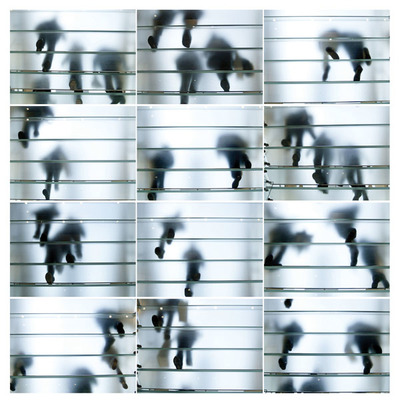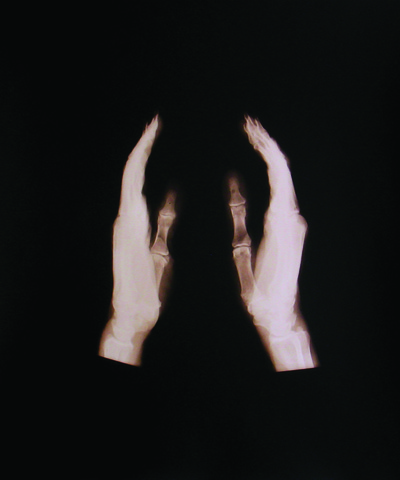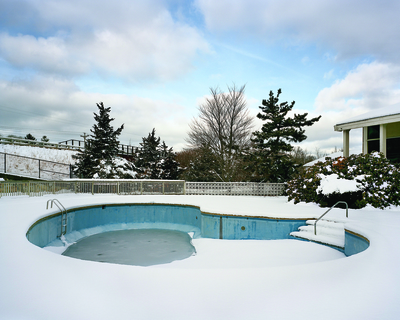Innovation & Heritage: Photography in New England
THE INVENTION OF PHOTOGRAPHY was confirmed by the Académie des Sciences in Paris in August of 1839. The Académie des Beaux-Arts soon after would concur with its pronouncement. The relation between photography and science, more intimate and complex 175 years later, distinguishes it among the fine arts.
From the daguerreotype to Instagram, photography has been an artistic and a scientific process, and often exists as a tug of war between the two. As a technology belonging to the field of physics, chemistry, optics, or computers, photography has been used to study everything from the stars to the double helix, becoming the “true retina of the scientist.”1 In Boston, where many academic institutions embraced photography as early as the 1930s for its technological potential, a unique and rich culture has flourished in this medium that values and promotes the art of photography.

Keith Johnson, Mac Music, Chicago, IL, 2010, archival pigment print.
Courtesy of Panopticon Gallery.
Much of that art, then and now, uses science to its own ends. Today, the roots of New England’s photographic community are deep, springing from sources as varied as Henry “Doc” Edgerton, György Kepes, and Minor White’s experimentation at MIT to Edwin H. Land’s Cambridge-based Polaroid Corporation, and its “one-step” camera. Curators and gallerists have not forgotten Berenice Abbott’s work for the Physical Science Committee or Harry Callahan and Aaron Siskind’s early graduate program at RISD, singular on the East Coast at the time. Innovation is and always has been central to photographic practice in New England, yet so, too, is a bountiful tradition. This duality is reflected in the work of contemporary photography galleries.
“Right now, I’m fascinated with what is coming out of the MIT Media Lab,” remarks Jason Landry, owner and co-director with Anne DeVito of Panopticon Gallery, Boston, established in 1971. “Contemporary artist and photographer Vik Muniz was in residence there last year and teamed up with members of their biology, optics, and engineering groups to develop a process to create microscopic images onto millimeter-wide grains of sand, which they enlarged into high-resolution images.” Landry has found ways to incorporate new digital technologies into his roster of exhibitions at Panopticon, but takes an eclectic approach that includes neo-Victorian cabinet cards by the Helsinki collaborative Atelieri O. Haapala, and traditional contact prints. This is not unusual for New England, where galleries show photography made with 8 x 10 cameras and Holgas alike.

Jo Sandman, Light Memory series, X-ray image. Courtesy of the artist.
Researchers at the MIT Media Lab Camera Culture group work on Femto-photography, which captures light as it travels at roughly half a trillion frames per second. Meanwhile, the Vermont Center for Photography, founded in 1998 in Brattleboro, recently has shown the vintage silver prints of octogenarian and original Photo League member Rebecca Lepkoff. Photography culture easily encompasses both directions, with those in the field open to the manifold possibilities of the medium.
Portland-based photographer Caleb Charland’s recent exhibition Backscatter at Gallery Kayafas, including a number of gelatin silver photograms, is a veritable portfolio of scientific wonder. N. W. Gibbons’s “agricultural” tintypes are subtly multidimensional as they interpret and arrest nature using the wet-plate process. Artist Jo Sandman takes a different tack, working with X-rays to create uniquely poetic photographs in the memento mori tradition, crafting aesthetic objects from diagnostic imaging. Her upcoming exhibition at Kayafas features stunning new work evolved from her Light Memory series.
Science and history are palpable in New England’s photography galleries. As curator Gary Van Zante explains, the Kurtz Gallery at MIT makes every effort to “reconnect with MIT’s long tradition of photographic investigation and instruction.” Its inaugural exhibition, Photography and Science: An Essential Unity, featured more than 70 images by Berenice Abbott, made while she was at MIT, in the late 1950s (reviewed in Art New England’s September/October 2012 issue). Reinvigorating a long tradition, strong contemporary work is typically paired with historical images. On view now, Stanley Greenberg: Time Machines explores the weirdly powerful world of nuclear and particle physics (see feature, p. 36 in this issue). In Connecticut, Chris Huestis founded PhotoSynthesis in 2008 as a place for
alternative, historical, and experimental
photographic processes.
Any discussion of photography in New England must praise the two big hitters on the scene, both nonprofits. The Griffin Museum in Winchester, MA (with three galleries and four satellites in contiguous towns) and the Boston-based Photographic Resource Center (PRC) are each dedicated exclusively to the art of photography. Through an exhaustive schedule of exhibitions and educational programs, they serve as hubs for the artistic community, expanding access to and cultivating appreciation for the photographic arts. Together, they jointly sponsor the New England Portfolio Reviews (NEPR), an opportunity for photographers to meet directly with curators and gallerists one-on-one. Since its founding in 1975, the PRC has encouraged the development of a community of artists. Joined in 1992 by the Griffin, they provide a bulwark of support for photographers from New England. “The Griffin is an organization where the emerging, emerged, and collector can stand together,” explains Paula Tognarelli, Griffin executive director and curator since 2002. The Griffin’s democratic platform insists on satisfying every photographic aesthetic—from photojournalism through the range of fine art—making them all credible. This is an atypical position in the field.
Photography as an art is constantly changing, its technological apparatus evolving to provide ever more diverse approaches. While some are quick to embrace new digital technologies, including increasingly sophisticated cameras on cell phones (not to mention Google Glass), others find the proliferation of photographic means and their relative ease of use challenging to the finer forms of photography. “Photography has always struggled to be recognized as a form of fine art specifically because of its technological element,” comments Huestis. What does excite Huestis these days is hybrid photography that combines digital and historical processes. The democracy of photography and its technological advances allow for greater creativity, although PRC curator Francine Weiss adds, “[they] put more pressure on fine art photographers to be innovative and original to distinguish themselves from the masses of photographers and floods of pictures.”

Brian Kaplan, Seashore Park Inn #2, 2012, archival pigment print. Courtesy of Panopticon Gallery.
The hybrid approach can be seen in full clarity in Maine’s local arts scene. Opened in 2013, PhoPa Gallery in Portland is a collaborative venture with the Maine Media Workshops dedicated to exhibiting Maine-related works and artists. In York, Stonecrop Gallery has been a home to artists for much of the past century, featuring the work of luminaries such as Barbara Bosworth, Jim Dow, Henry Horenstein, and Karin Rosenthal. Both Ralston and Harbor Works Galleries maintain a distinctive coastal aesthetic, appealing to the narrative capacities of the medium for stories of the sea and communities along the harbor, today and in the past.
There is much range in the region. The New Hampshire Society of Photographic Artists is a member-driven nonprofit supporting contemporary photography since 1998 through group exhibitions, publications, and a fall program on the Isles of Shoals. While Gallery 19/21 in Connecticut offers a selection of vintage European photographs from the 19th and 20th centuries, the Red Eye Gallery at RISD showcases the latest student work. Rich academic resources throughout New England have fundamentally shaped the field, as curator (formerly at the Fogg Art Museum) and photography specialist Michelle Lamunière points out. At Harvard, the Carpenter Center collection now houses more than 28,000 prints and negatives, from early geological surveys to vernacular photographs and Farm Security Administration (FSA) documents. In the early 1970s, Barbara Norfleet began amassing its collection of social documentary photographs for use in sociological research. Maja Orsic, director of the Robert Klein Gallery (RKG) in Boston’s Back Bay, likewise emphasizes, “The medium of photography is well-suited to New England, a region densely populated by institutions of higher knowledge and the arts.” Professors such as Callahan and Siskind informed the 20th-century understanding of photography as an art form and influenced numerous photographers, many of them still teaching in New England. Today Sharon Harper joins their ranks in Harvard’s Visual and Environmental Studies program, her conceptual and celestial work exploring the relation between photography and perception with the night sky as its interface.
Opened in 1980, RKG epitomizes the orbit of photography in the region. Its holdings span Eadweard Muybridge to Lewis Hine, Harold Edgerton to Olivia Parker. When asked about the breadth of photography in the area, Orsic comments, “Contemporary photographers in New England are exploring every corner of the medium. The Flash Forward Festival has been held in Boston for three years running; its success points to the energy and diversity of young talent in the region.” We now have Photo Nights Boston, which hosts the art festival Photorama, and PechaKucha 20×20 nights, held in some 700 cities around the world and throughout all of New England.
As a medium, an art, a science, and a technology, photography reinvents itself continuously and essentially. There is a hybridity in our spirited regional photography that seamlessly couples the deep roots of our photographic heritage and innovative practice, bringing us the best of both worlds, science and art. These have, demonstrably, hewn more common ground in New England than our 19th-century photographic forebears ever could have imagined.
1Jules Janssen, La photographie celeste, 1888, cited in CrossOver: Photography of Science + Science of Photography.
Robyn Day is a photographer who has shown her work nationally. She writes about the arts for Art New England, Aint-Bad Magazine, and Big Red & Shiny
